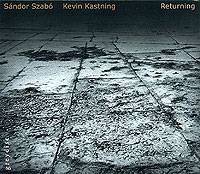 A
pretty amazing album of adventurous yet harmonious guitar duets, Returning
is the 2010 CD from guitarists Sándor Szabó and
Kevin Kastning. Reviewers have already compared Returning to
the early ‘70s classic ECM sound but, what benefits this album
even more is the modern, innovative recording approach, wider dynamic
range and expert sonic care that is skillfully implemented here. A
masterful guitar inventor and designer who works closely with the
Calilfornia-based Santa Cruz Guitar Company, Kevin Kastning performs
on his own 12 string extended baritone guitar as well as 6 string
bass baritone guitar while Sándor Szabó shares the recording
sound stage with his 12 string baritone guitar playing. Szabó
and Kastning released their 2009 Greydisc album called Parabola,
to great acclaim and now surely they’re poised for more accolades
with the 2010 CD release of Returning. Interesting to note,
the perfectionists these guys obviously are, the album was recorded
on July 5, 2008 (two years to the day this review is being written
by the way!) and was engineered by Kastning while the recording was
expertly mixed and mastered for CD by Szabó in his native Hungary.
Fans of the finest acoustic jazz fusion / neoclassical guitar masters—from
Abercrombie to Metheny to Kottke and Hedges—will appreciate the
guitar expertise in play on Returning.
A
pretty amazing album of adventurous yet harmonious guitar duets, Returning
is the 2010 CD from guitarists Sándor Szabó and
Kevin Kastning. Reviewers have already compared Returning to
the early ‘70s classic ECM sound but, what benefits this album
even more is the modern, innovative recording approach, wider dynamic
range and expert sonic care that is skillfully implemented here. A
masterful guitar inventor and designer who works closely with the
Calilfornia-based Santa Cruz Guitar Company, Kevin Kastning performs
on his own 12 string extended baritone guitar as well as 6 string
bass baritone guitar while Sándor Szabó shares the recording
sound stage with his 12 string baritone guitar playing. Szabó
and Kastning released their 2009 Greydisc album called Parabola,
to great acclaim and now surely they’re poised for more accolades
with the 2010 CD release of Returning. Interesting to note,
the perfectionists these guys obviously are, the album was recorded
on July 5, 2008 (two years to the day this review is being written
by the way!) and was engineered by Kastning while the recording was
expertly mixed and mastered for CD by Szabó in his native Hungary.
Fans of the finest acoustic jazz fusion / neoclassical guitar masters—from
Abercrombie to Metheny to Kottke and Hedges—will appreciate the
guitar expertise in play on Returning.
MUSIC WEB EXPRESS 3000
presents an interview with
SÁNDOR SZABÓ AND KEVIN
KASTNING
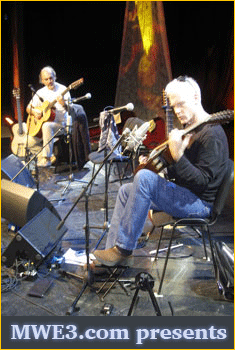 MWE3:
Tell us something about each of your musical backgrounds and how long
you’ve been playing guitar and any other instruments as well.
MWE3:
Tell us something about each of your musical backgrounds and how long
you’ve been playing guitar and any other instruments as well.
Sándor:
I started studying classical guitar at age 13 and then I tried all
the possible styles, rock, folk, jazz. Then my attention turned to
the real improvised music, and I also began to compose. In the meantime
I started to search for the eastern music and I went deeper into the
contemporary classical music also. By now all these influences determined
what and how I play now. From the beginning I played many different
kinds of acoustic guitars, nylon and steel strings, 10, 12, 16 strings,
fretless 8 and 24 string double neck koboz, baritone 6 and 12 strings.
Kevin: I began playing trumpet and piano when I was 7. I wrote my
first pieces that same year, too, using piano. To this day, I still
compose on piano, never on guitar. I added French horn when I was
about 10, the school orchestra needed a French horn, and I love learning
new instruments, so I volunteered right away. I started playing guitar
when I was 11 or 12. I also play mandolin and bass. Since about 2002,
I’ve been an artist endorser for Santa Cruz Guitars, and Richard
Hoover (owner/founder of SCGC) has been incredibly supportive, both
to me personally and to my music. The Santa Cruzes are perfect for
what I do, their voicing is so balanced and responsive. They have
built three instruments for me which I’ve basically invented:
the 6-string extended baritone, the 12-string extended baritone, and
the 12-string alto guitar. Some of the other guitars I play are fretless
acoustic 6-string and also classical guitar, as well as standard acoustic
6- and 12-string. My main instruments are the three KK series from
Santa Cruz. I’m working now with a very gifted luthier in Montana
named Daniel Roberts. I could never say enough good things about him.
Dan was at Santa Cruz when the two KK series baritones were built,
he had a big hand in both of those. At present, he’s building
another of my inventions called the Contraguitar. It will be a 14-string
instrument with a wider range than anything else. I suspect this will
become my main instrument.
MWE3: How did you two guitarists meet and what would you say was the
initial chemistry that led to your first recordings?
Sándor: Things never happen by chance. A few years ago I was
searching for baritone guitar makers, and I found Kevin Kastning as
an endorser of the Santa Cruz baritone guitars. When I listened to
his samples on his website, I thought that I found the most modern
American guitar player, who seemed to me as if he came from another
planet. Then when I toured in the States and Canada, I visited Kevin,
and at once we started to record. The chemistry was obvious and so
strong. When we started to play freely, he reacted and responded in
the music in a way that no other guitar player could. The improvisation
with him sounded as structured composition. It was refreshing to improvise
with someone who never used any jazz clichés.
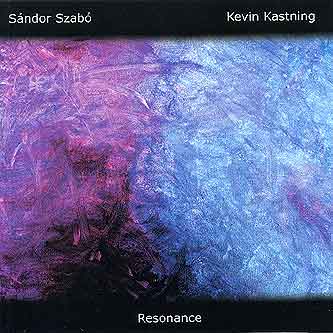
Kevin: In 2006, I received an email from Sándor. I had heard
of him, and knew who he was. He started by asking some questions about
the Santa Cruz KK baritones. We exchanged some of our albums, and
found that we had much in common both artistically and personally.
It wasn’t long until Sándor asked if I’d do an album
with him. I wasn’t looking for a new duet partner or collaborator,
but I knew that something special would come of this. I sensed I had
found a kindred soul. So I said yes. On our first studio session together,
we recorded the album Resonance in a single day. As an aside,
we’ve recorded all of our albums in a single day each. We both
knew we had a connection unlike any either of us had experienced,
I think we meshed musically more than either of us ever had with anyone
else. During a break in the recording sessions on that first day,
Sándor asked if I’d do an album per year with him. By
then, I knew we had to!
MWE3: Tell us about your new CD, Returning, when and where
it was recorded, some information on the way the album was recorded
and how it reflects your overall musicianship and/or guitar style.
Sándor: With Returning, we symbolically wanted to return
to the ‘Source’ of all the music,’ and we wanted to
show that the music still has the ritual and sacred power if it is
played properly. We think that there are many kinds of ways to improvise.
We have chosen the most difficult, when we just lift over the music
from another reality. When we play it is a ready and complete music,
nothing more to do with it. This means of course a lot of responsibility
from the player. We never experiment, because in the ‘source’
the music is waiting for to be reborn in and via the human soul and
it just manifests as a ready music on the instrument. When we play
in duo, we play in a different way. I am mostly a solo guitar player,
but I always play in a different way in duo. We are solved in each
other and this creates another kind of approach of the ‘source.’
Kevin: The compositions on Returning are more extended than
the pieces on our previous albums, not just in compositional duration,
but more extended in emotional depth, harmonic complexities, and even
structural form. One person wrote to me, and said they hear the pieces
on Returning as darker than the other records. I wouldn’t
refute that, I think that kind of depth and intensity can come across
as dark. With our records, I think each one goes deeper than the preceding
one. That is certainly true with Returning. We recorded Returning
in a single day in my studio in northern Massachusetts. It was tracked
live in the studio, just as you hear it on the record, no overdubs,
no EQ, no compression or limiting.
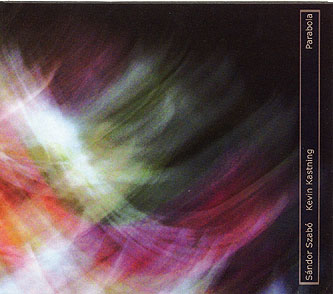
MWE3: How would you compare the sound of Returning to your
earlier CD duo releases Parabola, Parallel Crossings and the
Resonance albums? And can you describe the evolution in the
sound and/or development of musical ideas between the different recordings?
Sándor: Each album sounds a little different. However, we created
a typical sound which can be heard on all the albums. The difference
is much rather in the guitars and the tunings we played and used.
We are also different every time, so even if we do not want to change
anything, things changes and that can be heard.
Kevin: As far as sonics, recording and mixing, are concerned, I think
all our albums sound very good. I don’t know that the recorded
sound, the quality of the recordings, has changed all that much. The
evolution of the musical ideas, as you put it so nicely, certainly
has. Sometimes I think of our records as steps on a staircase, each
album is the next higher step. The communication between each other,
as well as with the source, is ever evolving and becoming deeper.
And is something I’m always pursuing.
MWE3: How did recording the Returning album with 24bit/96k
resolution impact the overall sound quality and can you describe the
special steps that were taken in the mixing and mastering stages?
Sándor: We recorded the albums in Kevin’s studio in a
high resolution hard disc recorder, using the possible highest quality
mics and preamps. The mix was done in my studio in Hungary also on
devices of the possible highest level. As for my recording concept
I have a very simple concept for recording acoustic guitar. I use
mics in stereo setup with Jecklin Disc. I try to find the only one
position which gives me the guitar real sound. I never record a guitar
with only one mic, it sounds if you had only one ear.
If all is recorded properly, there is no need for mastering, because
we start everything in the right way from the beginning. I never use
EQ and compressors. These units are forbidden from my studio. I am
trying to move the mics instead of using EQ until I get what I want
to hear. The only effect I use is a Bricasti M7 or a Quantec 2498
Space Simulator. These units sound much better and three dimensional
as even the best recorded space. In this way we keep the original
dynamics and the spectral range of the guitar and the result is a
very lifelike recording where you can have the illusion that you feel
the deepness, the width of the space, the distances of the guitar
in the space, and you can almost touch it. A very 3-dimensional audio
experience.
Kevin: Sándor and I divide up the work like this: I am the
recording engineer, and he is the mixing and mastering engineer. My
studio has nothing in the way of compressors, limiters, or EQ, everything
is accomplished with mic selection and placement. Everything was recorded
using Millennia microphone preamps, and a combination of Gefell, AKG,
and Neumann microphones. I have a coincident stereo mic pair on each
instrument, and put up a stereo pair of 414s as overheads, so we end
up with a 6-track master. I am blessed to have a studio which is a
good sounding acoustic space, and that comes across in the recording,
you’re not just hearing the equipment. Tracking at 24/96 results
in a much more detailed and three-dimensional soundscape for sure.
Sándor’s studio in Hungary is very high-end, just excellent.
Of course, having great gear doesn’t matter if you don’t
have the ears and know how to make an ideal mix. Sandor’s mixes
are wonderful, he’s got amazing ears and many years of studio
experience, and it shows. The only effect allowed on our recordings
is in the mix, we use the Bricasti M7 reverb unit. It is like having
Boston Symphony Hall in a box, everything just breathes and comes
to life with it. So with the careful mic selection and placements,
the high-res tracking in a great room all with the magic of the M7,
it makes for a very good sounding recording to say the least. I think
the depth and breadth of the sonics and recording quality of Returning
is palpably deep.

MWE3: The artwork on all four albums is very impressive. What kind
of effect were you going for regarding the artwork and packaging on
the CD releases?
Kevin: Thanks, Robert. I didn’t do any of the artwork or album
design on any of them. I will usually start by sharing my thoughts
with Sándor as to the kind of album cover I’m “hearing,”
based on the pieces for the album, and we’ll discuss what we’re
both hearing. We are always in agreement on this.
The last three albums were done by a great artist in Australia named
Lea Hawkins. Lea has been listening to my music for many years, and
I think she will sometimes know what the cover should be before I
do. I send her a copy of the final mix of the album, and a description
of what I’m going for in terms of a cover, a feeling, something
conveyed, things hinted at, a thematic overview, an essence, all based
on and connected to the compositions. Sometimes I will provide a vague
verbal compositional overview. She always creates something which
truly reflects the compositions on the albums, while at the same time
enhancing the impact of them, I think, by her art and design and how
it all is connected to, and is even an extension of, the music. Using
Returning as an example, I think the cover art is a palpable
crystallization of the music. The pieces have that sense of depth,
that texture, and then there is the fading into blackness which seems
to hover like a mist with this album. There is also a photo in the
gatefold inside the album cover which is connected. I am proud to
have Lea’s paintings and photography as our cover art.
MWE3: Tell us something about the guitars featured on the Returning
album, and any special guitar set ups, strings and pedals or recording
effects. Were the same guitars featured on the earlier album releases
too?
Sándor: On Returning I used a Lance McCollum 12 string
baritone guitar with different tunings. I use John Pearse strings.
I never use effects, I am a really purist acoustic guitar player.
On amplified concerts the only effect is a high level reverb unit.
On the earlier albums I used also the McCollum, sometimes with 6 string
setup, sometimes with 12 string. I do not remember the tunings, but
you can find some on my website.
Kevin: The main instrument for me on Returning is my Santa
Cruz DKK-12 Extended 12-string Baritone. I’m an artist endorser
for John Pearse, so all John Pearse strings for me. No effects or
special setups, but plenty of special tunings. I used my own intervallic
tunings on the entire album, and that is very freeing, these tunings
allow for harmonic depth and expression which just is not possible
with standard tunings. I can grasp textures and create entire harmonic
environments and establish densities which are otherwise unattainable.
There are no standard tunings used at all on the entire record. I
also used my Santa Cruz KK series Extended 6-string baritone in low
E tuning on a couple of pieces, and my alto 12-string guitar on a
couple of pieces. Everything else is the DKK-12, that is currently
my favorite instrument. On the other three records, I’m using
just the two baritones. The DKK-12 is usually my main instrument on
each record, with the DKK-6 used on a few pieces. Like Sándor,
I have most of my tunings posted on my website.
MWE3: Can you mention some of your musical influences, favorite guitarists
and most influential albums?
Sándor: Earlier I mentioned my music influences. Until my 30’s
I had favorite guitar players, but from that somehow I felt listening
to others will affect my playing in a bad way. I wanted to play in
my style, so from that point the favorite players became much rather
kind of handicap for me. Of course I follow what happens in the world,
but my path leads to different direction. One thing is sure, that
I was deeply influenced by John McLaughlin when I was 20-25, then
Ralph Towner and Egberto Gismonti. After my 30’s I just wanted
to hear ‘music,’ composers like Béla Bartók,
Zoltán Kodály, Arvo Part, Schoenberg, Berg, Wagner,
Debussy, etc. Now I am much rather interested in music than guitar
playing, which means that I am first of all a musician, and only then
a guitar player. Some albums are still my favorites from my early
years, like Between Nothingness and Eternity, Apocalypse,
from the Mahavishnu Orchestra, the Batik from Ralph Towner
and those two duo albums with John Abercrombie and Ralph Towner in
duo. Yes, those two albums were my reference duo guitar albums for
long time. Since I know the Kastning/Siegfried duo albums, the reference
has shifted quite a lot. These albums are not famous at all, but they
are genius. It was a big mistake always from my part when I wanted
to find the best musics only from the famous players. The deepest
musicians are unknown. All the famous guitar players became millionaires,
and they seem to have lost their real honest contact with the music
because they are part of an industry and as such they are not free
anymore. They cannot renew themselves anymore. Of course I respect
them a lot, they did a lot to the world of the guitar.
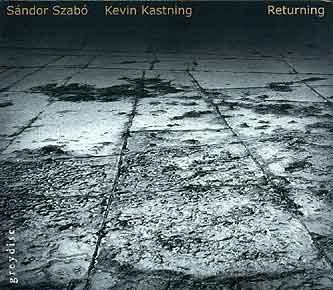
Kevin: My father was a musician, and when I was growing up, there
were always just piles of records around, everything from country
and western to jazz to classical. I would listen to his records for
hours and hours every day before I started playing an instrument.
From playing in school orchestras, I developed a deep love of classical
music. I don’t recall being all that impacted by guitarists,
my heroes were always composers. It is not an overstatement to say
that the work of Béla Bartók made an intensely profound
impact on me. Other heavy influences are composers such as Gesualdo,
Ockeghem, Bach, Beethoven, especially his late-period string quartets,
Schoenberg, Webern, Berg, Elliott Carter, Charles Ives, Schnittke,
Shostakovich…. It is quite a long list! I can’t really point
to specific albums which had an impact, but I can point to a few works
which did: Bartók’s string quartets, Alban Berg’s
1935 Violin Concerto, Elliott Carter’s string quartets, and Beethoven’s
late-period quartets. For me, Bartók’s quartets were like
the Rosetta stone and an artistic GPS rolled into one. I also cannot
underestimate the deep impact of the works of Carlo Gesualdo.
Favorite guitarists…. That’s tough. I don’t think I
have any! I always really enjoy Paul Galbraith and Goran Sollscher,
very much. Though not a guitarist, I really like Robert Barto performing
the Sylvius Leopold Weiss lute works, he’s playing multi-course
baroque lute. And of course Sándor is one of my very favorite
guitarists. His is a totally unique voice. When we did the European
tour last year, he would open each concert with a few solo works.
Standing backstage every night listening to that was a very spiritual
experience for me.
MWE3: What are your current and upcoming plans regarding your recordings,
new recording sessions and upcoming tours and performances?
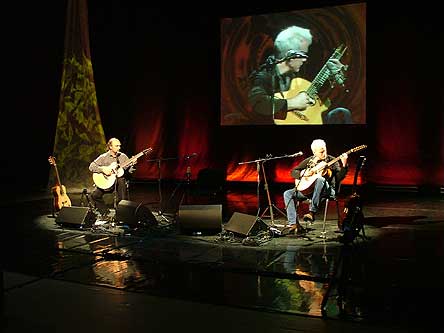
Sándor: Well, we have two more unreleased recordings with Kevin,
a duo and a trio together with Balázs Major on percussion.
I am quite scheduled now, here in Europe there is a decreasing interest
for the music that I created as a result of my Hungarian music researches.
This project is called Modern Hungarian Maqams. ( www.hunmaqam.hu)
I just returned from a 9 concert Estonian tour. People liked a lot
the ancient Hungarian instrumental music that I recalled 2000 years
later. Upcoming tours will be in Hungary, Mexico and Germany in the
autumn. We work on making European concerts with Kevin, however in
this time it is extremely difficult to find promoters for such a deep
music.
Kevin: As Sándor said, we have two more albums completed, the
first of those will be out in 2011. It will be a very special record,
it was recorded during the 2009 European tour. It was recorded on
location in a church in a tiny 9th century village in Hungary, in
the shadow of a castle which also dates from the 9th century. We also
have two other album projects in the works together, each will be
very, very different from what we’ve done so far. Our next European
tour is coming up, too. Siegfried and I have completed a new album
which should be out late this year or early next year. It is the best
work he and I have ever done together. I’m working on three solo
albums, each very different. I am working on an album project with
a wondrous reed player and composer named Carl Clements. I also compose
for non-guitar settings, for example, I’ve got about four or
five string quartets in the works right now, another piano sonata,
various trio sonatas. I have two duo album projects coming up with
two other artists. A bit too early to go into specifics right now,
but I’ll be making announcements on my website soon.
MWE3: Can you tell us your web site and email contact info?
www.sandorszabo.com
www.hunmaqam.hu
sandorszabo1@yahoo.com
www.kevinkastning.com
www.myspace.com/kevinkastning
kastning@gmail.com
And also:
www.leahawkins.com
(Lea is the artist that creates our album art and does all the album
design work.)



